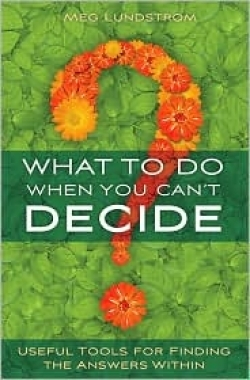
What To Do When You Can't Decide
Useful Tools for Finding the Answers Within
A scientist in California recovers her daughter’s stolen harp with the help of an Arkansan dowser and an Oakland map, an experience which turns her scientific worldview upside down. Receiving spot-on answers to daily decisions in ways the rational mind doesn’t understand creates, at the very least, some challenges and possible opportunities.
In What To Do When You Can’t Decide, author Meg Lundstrom, co-author of The Power of Flow, sets the stage for readers willing to explore answers that emerge from within. She explains what divining is saying, “…another way to make decisions…that work out astonishingly, unexpectedly well. It allows you to tap into the part of yourself that is wiser, calmer, and all-knowing.” Readers learn how and why it works, with historical and scientific contexts. For everyday skeptics, the author introduces a sense of play with the techniques, illustrating their validity with stories and showing how to tailor them to users’ preferences.
The book also details the step-by-step heart of the techniques for three types of divination: muscle testing (called kinesiology); working with a pendulum; and accessing answers with paper chits. The five starting essentials (“Get quiet. Get connected. Get neutral. Pose the question. Receive the answer.”) affirm the spiritual connection that helps users be effective. Exercises, like “Getting Head, Heart, and Body into the Act,” help readers gain trust in these novel ways of displaying internal knowing. Lively chapters (with names like “Swing Dancing with the Divine,” and “Popping the Question,”) extend the how-to into advanced techniques for pendling and muscle testing. The author’s anecdotes, plus perspectives from experts, draw readers into divination’s possibilities.
Using chits, or folded pieces of paper with the answers written on them, can’t be explained by traditional science. Its effectiveness owes much to a quantum understanding of the world as interconnected energies. One chapter highlights briefly the numerous other divination methods.
Hands-on tools like checklists, troubleshooting tips, explanations of which tools work best in different situations, downsides to using the tools, exercises, and resources open the door for those who want to practice and go deeper.
Although divination may be perceived as unlikely, or “woo-woo” fantastical, to the rational mind, in a complex world with too many choices, it’s a portable tool that helps make sense of choices. This book offers a down-to-earth guide that fills a gap in the self-help shelf between volumes on how to increase intuition and the technical how-tos of dowsing.
Reviewed by
Bobbye Middendorf
Disclosure: This article is not an endorsement, but a review. The publisher of this book provided free copies of the book and paid a small fee to have their book reviewed by a professional reviewer. Foreword Reviews and Clarion Reviews make no guarantee that the publisher will receive a positive review. Foreword Magazine, Inc. is disclosing this in accordance with the Federal Trade Commission’s 16 CFR, Part 255.
